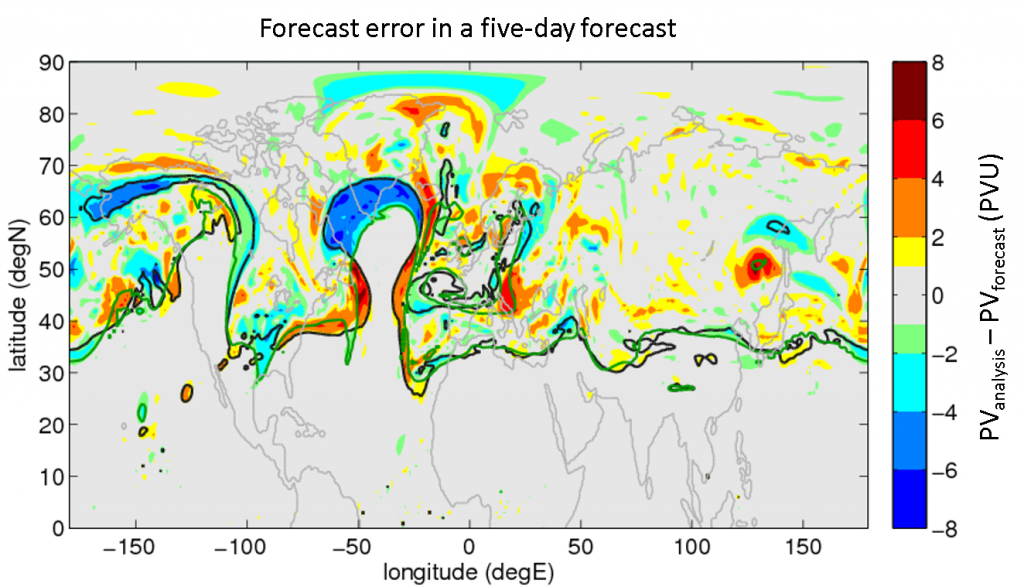For the past few months I have been thinking about differences between what the forecasts predict and what happens in reality and trying to understand how and why forecast errors develop. These questions might seem simple, but are in fact very challenging. They are also very important, because if we want to make further progress into weather forecasting, we need to understand the origin of forecast errors in current models to avoid them in future versions. Figure 1 shows one example of forecast error. It shows waves in the tropopause, the region that separates the troposphere from the stratosphere. The black line represents the waves that actually occurred. The green line represents the waves as predicted by a 5-day forecast. The colour scale indicates the magnitude of the error, with dark blue and dark red representing large errors. In this case the largest error occurred over the North Atlantic where a large-amplitude wave developed in reality, but not so much in the forecast.
Figure 1. Forecast error (analysis minus forecast) in a 5-day forecast of potential vorticity (PV) at upper levels (320 K isentropic surface). The black and green lines represent the tropopause in the analysis (close to reality) and the forecast, respectively.
Before going into further details we should establish that to know the future of any system we need to know the present state of that system as well as the laws that govern its evolution. For example, if we want to know where a satellite orbiting the Earth will be in the next 6 hours we need to know its position and velocity now as well as Newton’s laws to determine how the satellite’s motion will be affected by the gravitational pull from the Earth.
In certain systems, like the satellite in the example, it is sufficient to know just an approximation to the present to approximately know the future. Unfortunately, the atmosphere is not one of those systems: if we only have an approximation to the present state of the atmosphere, it will be impossible to know what the atmosphere will be doing in two weeks from now. This is because two atmospheric states that differ only slightly from each other will lead to completely different futures. This is what is known as sensitivity to initial conditions. This is an intrinsic characteristic of the atmosphere and there is nothing we can do to change it. Sensitivity to initial conditions constitutes a big hurdle when we are trying to predict what the weather will be like in two weeks’ time. To be able to do this we would need to know with infinite precision the current state of the atmosphere. Otherwise, small errors will grow, leading to a completely different state to that in which the atmosphere will actually be. Thus, our current efforts to predict the weather are limited by not knowing the current atmospheric state in sufficient detail.
The second ingredient that we need to predict the future of a system are the laws that govern its evolution. And here we run into more difficulties. Forecasting the weather heavily relies on the use of computer models run with the help of very powerful supercomputers. However, the equations that these supercomputers solve are only approximations to the actual equations that govern the atmosphere’s evolution. This means that in some sense the atmosphere in our supercomputers is a different atmosphere to the atmosphere in which we live. To make things even more complicated, the atmosphere in our supercomputers is also sensitive to initial conditions, but not necessarily in the same way as the actual atmosphere is! Why not? Simply because the equations that govern the actual atmosphere and the computer models are strictly different to each other.
In summary, there are three factors that intervene in the challenge of understanding forecast error:
(1) Sensitivity to initial conditions in atmosphere and computer models,
(2) incomplete knowledge of the state of the atmosphere at a given time, and
(3) incomplete representation of the laws of physics that govern the evolution of the atmosphere.
I am almost out of space for now. In my next contribution in September I will talk more about the methods that are used to understand forecast error and some results.

